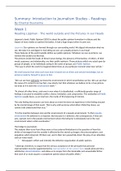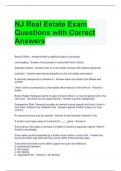Summary
Summary Readings Introduction to Journalism Studies
- Course
- Institution
Samenvatting van alle artikelen die gebruikt worden in het vak Introduction to Journalism Studies. Vak gegeven door Ansgard Heinrich. (Samenvatting is handig te gebruiken in combinatie met Summary Lectures Introduction to Journalism Studies). De samengevatte artikelen zijn: Week 1 Lippmann, W. (1...
[Show more]












